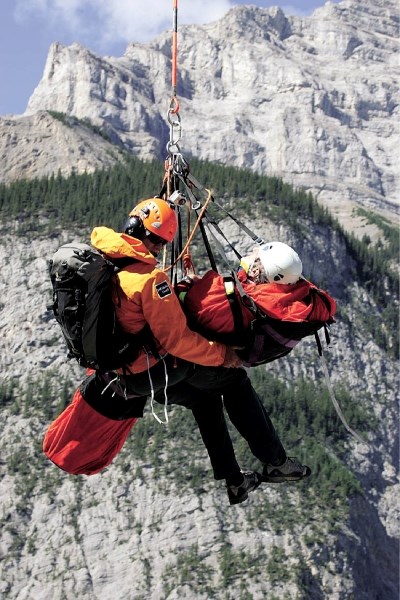So there you are, enjoying the great outdoors (the real thing, not the movie) when you find yourself lost, maybe injured due to an accident and with darkness falling.
This is not the time to realize you’re short of emergency gear, the kind that can mean the difference between getting back to civilization – or not.
Every year, in all seasons, Parks Canada and provincial mountain safety specialists are called upon to rescue individuals who find themselves in serious situations – whether due to accidents or dumb-ass decisions – and can’t get themselves out.
Often, these individuals have run into problems simply because they are unprepared; and the Rockies can be unforgiving.
Fortunately, heading out there decently equipped isn’t cost prohibitive and it won’t weigh you down unduly.
While there is all manner of both low-tech and high-tech emergency gear out there, the best bet is to have a selection of essentials, as Burke Duncan, public safety specialist, Kananaskis Region, calls them.
Fortunately, the number one item on the list is free, adds no weight to a pack and is carried at all times anyway; your brain.
In fact, says Duncan, “the number one navigation aid is your brain. It’s as simple as being able to get from point A to point B. It’s as simple as realizing the sun is on one shoulder as you head in a certain direction, and keeping it there.”
Essential to getting both into and out of the backcountry is a low-tech map and compass and knowledge in their use. For those who enjoy higher tech, a GPS unit or something like a SPOT (satellite messenger) device can be invaluable, but they are subject to the problems any electronic device can encounter or be subjected to.
Like a cell phone, which too many people rely upon in case of emergency, electronic units’ batteries can die, or the units can be broken in a fall. Two GPS units Duncan has used crapped out in the backcountry; not a problem for an expert with map and compass, though.
In regard to electronic aids, a past instructor of Duncan’s said, “Never trust anything that goes beep.”
Beyond navigation aids, Duncan recommends sufficient food and water be carried, along with extra clothing or rainwear as necessary. As well, matches/firestarter, a small first-aid kit, knife and sunglasses and sunblock and bear spray should be carried.
All of the above will take up little space in a pack.
When you do head out, though, Duncan has other tips for getting safely back. One is to not travel alone or, if in a group, to not split up if something goes wrong. “Splitting up is a classic mistake,” said Duncan. “We get so many calls where a group is hiking, then they split up, then someone is late at a meeting point or time. Often, it’s nothing, just someone taking a different loop, or a misunderstanding, but we still have to respond in full.”
Of course, going it alone presents its own problems, in that should something bad happen, there is no help close at hand. Last winter in Kananaskis Country, for example, a backcountry skier was caught in an avalanche and luckily was buried only chest deep, with one arm free. Even luckier, he managed to get at a cell phone and, because he was in one of few areas where there was reception, was able to call for help.
“If there hadn’t been a window of cellphone coverage there,” said Duncan, “he likely would have died.”
Too often, backcountry users rely on a cellphone to get them out of trouble. But in K-Country, vast areas have no cellphone coverage and a 911 call would be futile.
“In much of Kanananskis Country, there is no hope, not a trace, of cellphone coverage and people need to keep that in mind.”
Still by way of gear, Duncan has noticed a very common key component of backcountry incidents – unsuitable footwear. “A lot of people are out there with inadequate, low-cut shoes that give no support. You need a good sole, with a good grip, especially when it’s muddy, wet or icy, and you need ankle support.
“A lot of incidents where people were injured last summer was because they were wearing really crappy footwear.”
At this time of year, with rain a conspicuous feature of weather reports and runoff from altitude still coming down, quickly rising water in creeks can become an issue.
Cougar Creek and in Grotto Canyon, as well as others, may be little more than a trickle at 9 or 10 a.m. when hikers head out. “But with hot weather days and lots of snow still at elevation, or in combination with rain, a creek can be four or five feet deep later in the day,” said Duncan, “and it can take until 3 to 5 a.m. for the level to go down.
“In some places, a creek can go from a trickle to impassable in a few hours.”
Something else to keep in mind, especially when it comes to packing extra suitable clothing is, it can take a while for a rescue team to get to your location. And if the team needs to be helicopter-borne, a rescue is then subject to the limitations of weather and darkness.
For that reason, Duncan said, safety experts would prefer an assistance call come in early, not after a situation worsens to the point a rescue is necessary.
Finally, even if you’re not in trouble out in the boonies, you can assist the rescue efforts of others by knowing a simple helicopter signal. Recently incorporated by Alberta and B.C. provincial parks and national parks, the yes or no signals (see illustration) quickly alert a searching helicopter crew as to whether or not you require assistance.




